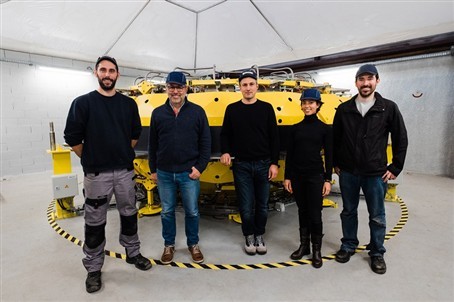Pre-Compression Rings facility ready. Let the tests begin!

(L-R): C. Legros (CNIM), L. Semeraro (F4E), R. Besson (CNIM), A. Hernandez Sanchez (F4E), V. Lecuyer (Douce Hydro) at the ITER Pre-Compression Rings Facility, CNIM, La Seyne-sur-Mer, France.
A group of engineers working in the ITER project has arrived at a brand new 140 m2workshop located in La Seyne-sur-Mer, south of France. The small town takes pride in having of one of Europe’s finest shipbuilding yards. But as of today, it is the host of a facility where some of the equipment of the biggest energy experiment will be tested. CNIM, a company with a long history in the fabric of the community, in collaboration with Douce Hydro have completed the ITER Pre-Compression Rings test facility. The contract has been awarded to the consortium by ITER Organization. The conceptual designs of the facility and its technical progress have been followed by F4E.

In the centre of the workshop a large piece of equipment consisting of 36 actuators is ready to flex its muscles exercising a force of 1000 t each. They will test the quality of each of the pre-compression rings by checking their resilience to high loads. When one of them is positioned on the tool, the 36 actuators will start to operate simultaneously, maintaining an accuracy of 0.1 mm while releasing a total force of 36 000 t. It is similar to the pressure exercised by 6000 African elephants, the biggest mammals living on land, when they walk. The stress tests will last a few hours and will be supplemented by other tests to confirm that the creep and fatigue performances are also adequate.

Approximately 40 people have been working round the clock the last 18 months to meet the tight schedule making sure that the facility is fully operational. The first tests will be performed during the first quarter of the year when the first pre-compression rings prototypes will be delivered. “F4E and ITER Organization, in collaboration with the CNIM/Douce Hydro consortium, have worked very hard to deliver this infrastructure on record time. The good team spirit and the commitment of all parties to see this project through have helped us to meet our tight deadline,” explains Luigi Semeraro, F4E Metrology Group Leader.
What is the function of the ITER requires Pre-Compression Rings?
The 18 Toroidal Field (TF) coils will create a massive magnetic cage to confine ITER’s super-hot plasma. While keeping the hot gas away from the walls of the vacuum vessel, they may experience some fatigue or deformation resulting from the powerful magnetic fields. Nine pre-compression rings hold the key to the survival of the TF coils. They will need to be positioned at different levels—three on top and three below the inner “vault” formed by the wedged noses of the TF coils. An extra set of three will be manufactured as spare in case there is any future need to replace the lower set. The pre-compression rings have an inner diameter of approximately 5 m, a cross-section of nearly 300 x 300 mm and will weigh roughly 3 t each. They are made of fiberglass composite, consisting of more than a billion minuscule glass fibers, which will be glued together using epoxy resin. Europe is responsible for their production.